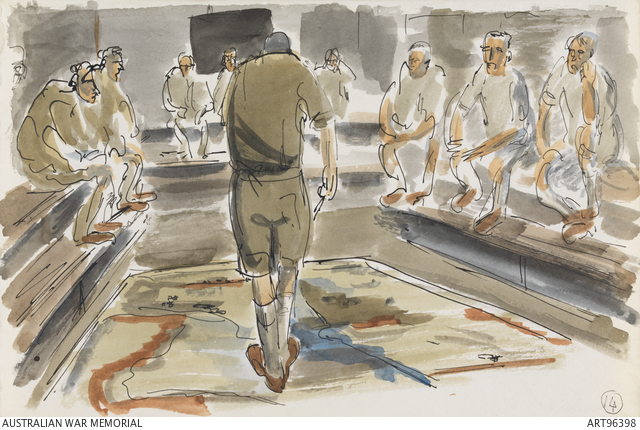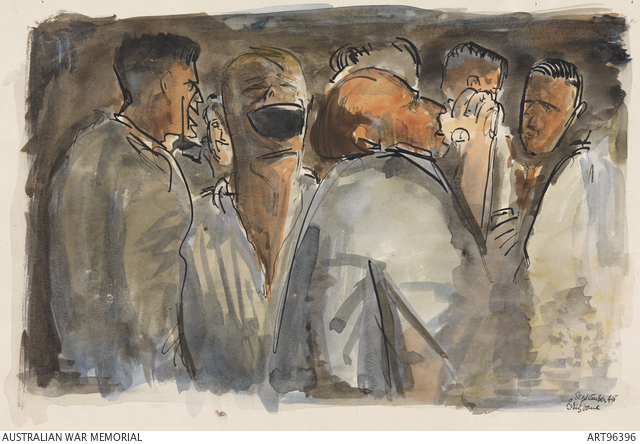Recent donation of rare watercolours by John Brack
Recent donation of rare watercolours made by John Brack while in the army during the Second World War.
In 2014, the Australian War Memorial received a generous donation of twenty drawings and watercolours by the Australian modernist artist John Brack (1920—1999). This donation is particularly significant because there are very few examples of Brack’s experience of his army life (1940—1946) in the National Collection. The drawings further our knowledge of the day to day experience of life inside Australian Prisoner of War camps. They also contribute to our comprehension of the impact of the Second World War on one of Australia’s most significant modernist painters.
When Brack joined the Australian army in 1940, he trained to become an instructor at the Australian army artillery school. He depicted this in [Map instruction], 1945. Although army life did not allow him time to paint, he spent his free time in the evenings making studies in pen and ink, pencil and watercolour.[1] Primarily they were sketches of his surroundings, the Murchison Camp in Victoria. This particular camp housed mainly Italian, some German and after 1944, Japanese prisoners. The desolate, flat expanses of the Australian landscape and the unbroken repetition of the buildings of the camp suggest a bleak and unvaried experience for the prisoners and the soldiers who guarded them.
In both his drawings of Prisoner of War (POW) and soldier life, Brack turned his attention to the depiction of figure groups. He used the motif of repetition of the figures to stylistic effect. In his sketches of the prisoners he depicted groups of prisoners walking together, and yet they remained detached from society. Isolated by language, cultural difference and incarceration they walk with hands in their pockets and their heads bent low. The artist in his early 20's imbued these drawings with feeling, including the sense of entrapment and the consequent misery of the prisoners. In his depiction of soldiers, Brack explores the use of abstraction of the human figure through the sameness in his depiction of groups.
In the depiction of social situations in both [Waiting] (1945) and [Drinking beer at the pub] (1945), Brack communicates social isolation within groups. There is a sense of belonging and yet being outside of the social situation. This physical distance allowed Brack to explore his artistic interest in abstracting the human figure. The social camaraderie amongst the soldiers who guarded the camps is contrasted with the tensions and hostilities associated with POW life in the camps. As he was constantly on the move, Brack’s drawings attest to a fluctuating sense of belonging.
As a result of the artists frequent movement during his army service, many of Brack’s drawings were discarded or destroyed.[2]However, the letters that Brack wrote to then girlfriend Ruth during this turbulent time reveal the young artist’s experience of social detachment and isolation during these years. It was through his wartime experience of ‘seeing himself consciously in exile’, that Brack made significant decisions in relation to explorations of tone and composition that would resonate in his future work. [3]
Despite the fact that Brack did not consider these army drawings as part of his oeuvre, they never the less remain historically significant works that informed the artist’s future direction.[4] Above all, they testify to Brack’s abiding interest in human form. The use of repetition is a motif that would reappear in many of his later works including the iconic painting Collins street 5pm, (1955). It is now more relevant than ever to reassess John Brack’s oeuvre in the light of these early artistic expressions that he created while he was in the army during the Second World War.
- [1] Grishin, Sasha The Art of John Brack, Oxford University Press Australia, p.16
- (According to biographer Sasha Grishin, Brack made hundreds of these studies, however only as few as 47 remain).
- [2] Ibid, p.19.
- [3] Grishin, Sasha The Art of John Brack, Oxford University Press Australia, p.19.
- [4] Helen Brack, ‘This oeuvre-the work itself’, In Grant, Kirsty, John Brack, National Gallery of Victoria, Melbourne, 2009, p.11.



